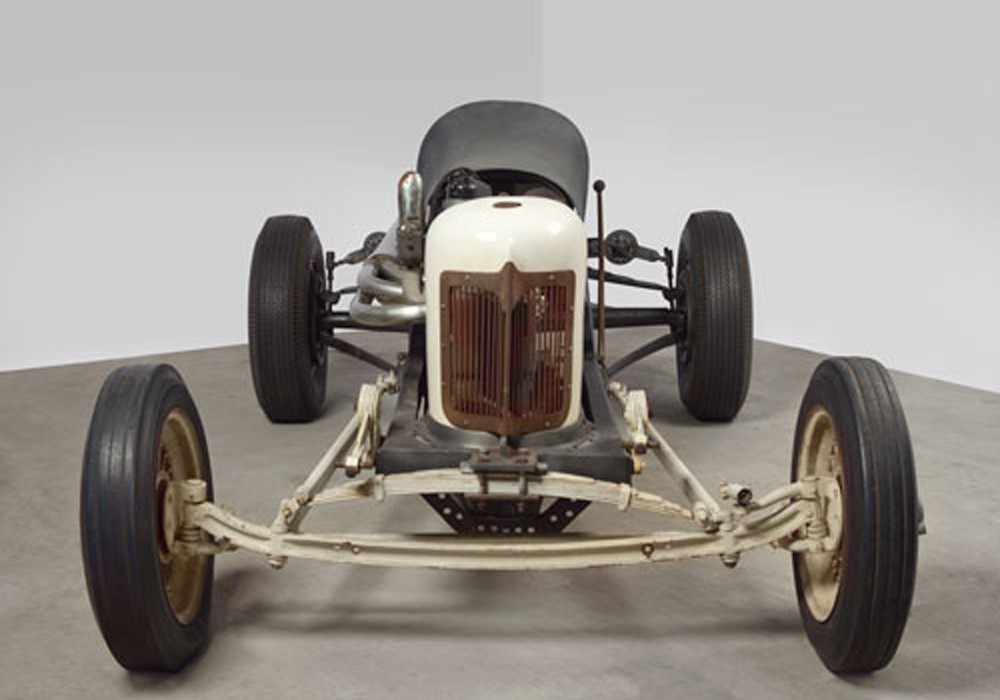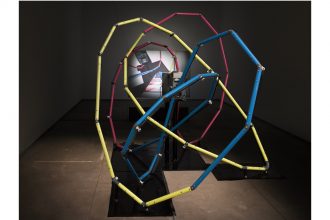Salvatore Scarpitta’s solo show at the Hirschhorn Gallery, Traveler, includes two race cars, a burnt-out sled, canvases that had been slashed, layered, and strung with car parts, and a snowshoe strapped and hung on a wall. The gallery text insists that Scarpitta was interested in themes of “risk, movement, death, and rebirth.” It is a show of bravado and masculinity, and so, surprising for the enjoyment it provokes in the spaces between. Why doesn’t Scarpitta’s machismo and self-mythologizing rankle? Why do his attempts to parallel artistic production with the niche subject of racing feel serious, profound? Why, despite his clear debt to the Italian Futurists – an art historical movement that’s now regarded as “embarrassing,” by some – does his output feel oddly endearing?
It might be a simple case of good timing. Traveler emerged in a year that saw countless exhibitions, essays, and panel discussions focusing on the legacies of modernism and, in particular, minimalism, and Scarpitta’s inclusion feels apt, an artist undoubtedly borne of this era. After surviving World War II in Italy, he moved to the United States at the invitation of New York art dealer Leo Castelli, and became a part of that roster alongside artists including Frank Stella, Dan Flavin, Richard Serra, and Bruce Nauman. Yet while Scarpitta’s unusual career trajectory landed him directly in the midst of a heady moment in modernist art, he largely stood apart.
This distance first becomes apparent in the illusionism that surfaces throughout his earliest efforts, which open the Traveler exhibition. Ostensibly, these “bandage paintings” share the key focus of all minimalist art: the object. In paintings such as Moby Dick (Extramural-Composition n. 3) (1958) and Nikos (1958), large swaths of canvas are cut up, bound around the frame, and layered with oil paint and more canvas. In shades of white, beige, and grey, the canvases appear mummified. They’re strapped down, and restrained. But even when Scarpitta focuses on the art object itself – with these paintings he attempted to break open the picture plane – he drags so much with him. Looking at these bandaged canvases, it’s impossible not to connect them to war. These are works so much as wounds.
With the exhibition largely arranged chronologically, the focus shifts with the suggestion of time’s passage. By the late 1960s Scarpitta no longer focuses on the object. He fully embraces interests beyond art itself, engaging with subjects like racing and escape. After applying various car parts to canvases for a time – his Extramural paintings – Scarpitta forgoes the canvas entirely and strips his output down to its most necessary feature: the car. Two automobiles-turned-sculptures, Sal Cragar (1969) and the much later Trevis Race Car (Sal Gambler Special) (1985), sit in the gallery, facing one another. Dismantled down to a shell, Sal Cragar’s blackened surface seems ghostly. It forms more of a void than an object. Surrounding the cars, archival photographs illustrate Scarpitta’s time spent owning and operating a drag-racing team. This period marks one of nearly excessive indulgence. These are far from the strongest works in the exhibition. Their sheer literalism limits them, cutting them off from resonating as deeply as Scarpitta’s other experiments. Nevertheless, it seems a necessary phase; a push against work focused on the theoretical and formalist.
Finally, Scarpitta’s separation from the other artists of his generation, particularly Donald Judd, becomes clear. Two sculptures, positioned together, highlight the entirely unspecific nature of his objects: Cot and Lock Step n.2 Cargo (1989/2000) and Osoppo 44 (1990). A sled of wood and canvas fabric, Cot and Lock Step n.2 Cargo carries the singed remains of a billboard hit by lightning, which Scarpitta added to the work in 2000. Practically charcoal, the sled’s contents match Osoppo 44, a single ski stood upright against the wall. Two distinct pieces, they seem made for one another: their chiaroscuro palettes and rectilinear forms seamlessly blend. Even their scales coincide. Beyond their aesthetic resonance, the slight hint of narrative, their seemingly missing rider, binds them. This lack of individuation, this ability to effortlessly combine two separate works thirty years after their making, divorces Scarpitta entirely from the minimalists. He abandons context. The space around and relationships between objects makes no difference to his work. These pieces can be reassembled and recombined, seeming all the stronger for it.
Because of his malleability, Scarpitta worked proficiently, but never comfortably, in an era where theory underpinned artistic production. Traveler underscores the full extent of Scarpitta’s de-localization. He hovers between movements and continents. Throughout, the themes of speed, war, and technology mark Scarpitta as a clear inheritor of the Italian Futurists’ interests and territory. But it’s a complicated lineage. Where the Futurists embraced the promises of technology and warfare, Scarpitta wrestles with their leftovers. Far removed from a position of contented acceptance, Scarpitta appears haunted. He also maintains an uneasy relationship with his peers, the minimalists. Though circling their world, at times welcomed and at other times an outsider, he never fully sublimates his biography, or his burdens. And this individualism, this neurotic working-through of his past, makes Scarpitta fascinating, despite his constant teetering on the precipice of cliché. Although Scarpitta’s work resonates visually with art of the late sixties and seventies, its spirit lies in a decidedly earlier period. An element of early modernism’s bohemianism creeps in. This mélange does not empty Scarpitta’s work or render it superficial, although it does ensure that the exhibition feels pleasantly out of step.



























